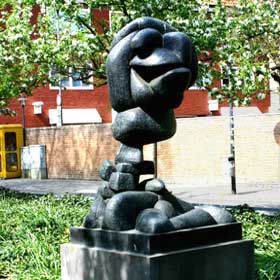basic
concept: „Stones without Borders“ -
and:
"Otto
Freundlich" ![]()
„Steine ohne Grenzen“
- „Stones without Borders":
The projects' background
is the idea of Otto Freundlich,
to connect the cultural centers of West and East, Paris and Moscow,
by a sculpture-way, a way against intolerance and xenophobia, for
peace and humanity. The idea is a result of his own experience in
the between-war-period in Europe.
The
existing "Skulpturenlinien"
- "Sculpture Lines"
in
Berlin and Brandenburg present a broadly based view to international contemporary sculptors' work. Until now, more than 100 sculptors from 25 nations have
participated.
Otto Freundlichs'
conception is dominating, not the touristical improvement of a region
or a city-centre.
According
to the conception of the initiators, Rudolf J. Kaltenbach und Silvia Christine Fohrer,
the "Skulpturenlinien" will be continued in further European
countries. In Krastal/Austria and in Ostrava/Czech Republic, according
activities did take place already.
Otto
Freundlich
– Painter and Sculptor –
born 1878 in Stolp,
murdered 1943 in Majdanek
Nowadays you'll find works of Otto Freundlich in most mueums . This
can't be taken for granted , because for a long time this important
artist wasn't even percipienced, especially in Germany. In Nazi-Germany he,
as a Jew, was persecuted. One of his sculptures, called "The
new man" was printed as cover of the exhibitions' catalogue
to "Entartete Kunst" ("Degenerated Art").He
was murdered in KZ Majdanek.
At the beginning of 20th century
Otto Freundlich, together with some well known vanguard artists
in Berlin and Paris, was searching for new ways of enunciating.

Otto
Freundlich, Ascension,
Bronzeguss 1929, Münster
He was a friend of Matisse, Picasso,
Modigliani Gris and Braques. He didn't join a artists' group but
chose his own singular way. In practicing and in theorethical essays he developed
a new understanding for the expression of art. He wanted to introduce
art into common social life.
Even in 1942, in the deportation
camp of St. Paul-de-Fenouillet, he wrote: "The work of the
artist is a sum of constructiv acts. The culture of an artist was
and is the same always: to prepare for the future". And "
... Art pursues the Universal. Separating abolishes her. Art openes
for men a specific dimension: imagination."